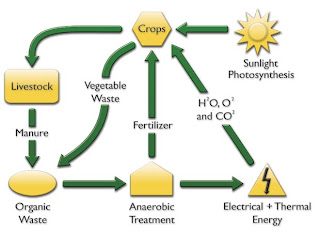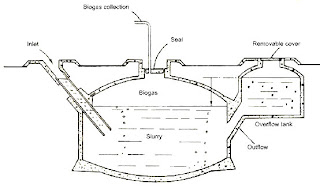Agro Industries | Biogas | Biogas typically refers to gas produced by biological degradation of organic matter in the absence of oxygen. Biogas is derived from natural materials and the type of biofuel. Biogas is produced by anaerobic digestion or fermentation of biodegradable materials such as biomass, manure, sewage, municipal waste, green waste, vegetable and plants. Biogas is composed primarily of methane and carbon dioxide, and may have small amounts of hydrogen sulfide, moisture and siloxanes.
Biogas can provide a clean, easily controlled renewable energy from organic waste to a little work, firewood, or replacement of fossil fuels (which will become more expensive as supply lags behind demand). During the conversion levels of pathogens are reduced and plant nutrients more readily available, to better crops can be grown, while existing resources are preserved.
The gases methane, hydrogen and carbon monoxide can be combusted or oxidized with oxygen. This energy release allows biogas to be used as a fuel. Biogas can be used as a fuel in any country for any heating purpose, such as cooking. It can also be used in anaerobic digesters where it is typically used in a gas engine to convert the energy in the gas into electricity and heat. Biogas can be compressed, much like natural gas, and used to power motor vehicles. In the UK, for example, It is estimated to have the potential to replace around 17% of vehicle fuel. Biogas is a renewable fuel, so it qualifies for renewable energy subsidies in some parts of the world. Biogas can also be cleaned and upgraded to natural gas standards when it becomes biomethane.
Biogas is practically produced as landfill gas (LFG) or digester gas.
A biogas plant is the name often given to an anaerobic digester that treats farm wastes or energy crops.
Since small scale units can be relatively simple to build and operate biogas should be used directly if possible (for cooking, heating, lighting and absorption refrigeration), since both electricity generation and compression of gas (for storage or use in vehicles) use large amounts of energy for a small output of useful energy. This concept is suited to "distributed" systems where waste is treated near the source, and sludge is also reused locally, to minimise transport and initial capital cost compared to a "centralised" system. As the distributed system will need a support network biogas contributes to the "triple bottom line"; benefiting the environment, reducing costs and contributing to the social structure.
Biogas can be produced utilizing anaerobic digesters. These plants can be fed with energy crops such as maize silage or biodegradable wastes including sewage sludge and food waste. During the process, an air-tight tank transforms biomass waste into methane producing renewable energy that can be used for heating, electricity, and many other operations that use any variation of an internal combustion engine, such as GE Jenbacher gas engines. There are two key processes: Mesophilic and Thermophilic digestion. In experimental work at University of Alaska Fairbanks, a 1000 litre digester using psychrophiles harvested from "mud from a frozen lake in Alaska" has produced 200–300 litres of methane per day, about 20–30 % of the output from digesters in warmer climates.
Landfill gas is produced by wet organic waste decomposing under anaerobic conditions in a landfill. The waste is covered and mechanically compressed by the weight of the material that is deposited from above. This material prevents oxygen exposure thus allowing anaerobic microbes to thrive. This gas builds up and is slowly released into the atmosphere if the landfill site has not been engineered to capture the gas. Landfill gas is hazardous for three key reasons. Landfill gas becomes explosive when it escapes from the landfill and mixes with oxygen. The lower explosive limit is 5% methane and the upper explosive limit is 15% methane. The methane contained within biogas is 20 times more potent as a greenhouse gas than carbon dioxide. Therefore uncontained landfill gas which escapes into the atmosphere may significantly contribute to the effects of global warming. In addition landfill gas' impact in global warming, volatile organic compounds (VOCs) contained within landfill gas contribute to the formation of photochemical smog.
Basic Biogas provides some introductory material, the Safety page provides some important information, Science Fair Projects and the Poly Digester pages give ideas about smaller projects and Anaerobic Digestion gives a bit more detail and information about larger projects. - AGRO INDUSTRIES
Biogas
zebec biogas, marches biogas, gwe biogas, biogas h2s removal, energen biogas, biogas desulphurisation, renewable energy biogas, manufacturers biogas digester, biogas boilers, biogas renewable energy, portable biogas analyzer, biogas storage system, biogas storage tanks, biogas digester suppliers, biogas analysis










Thanks for giving the clear ideas regarding Biogas fuel indirectly or directly Agriculture Parts are also helping for its creation.....
ReplyDeleteIn addition to generating energy, biogas systems help stimulate ecologically closed-loop systems in the agricultural sector while serving to improve soil quality and promote progress in animal husbandry. Biogas for urban is fast emerging as one.
ReplyDeleteRecycling of Waste in Bangalore